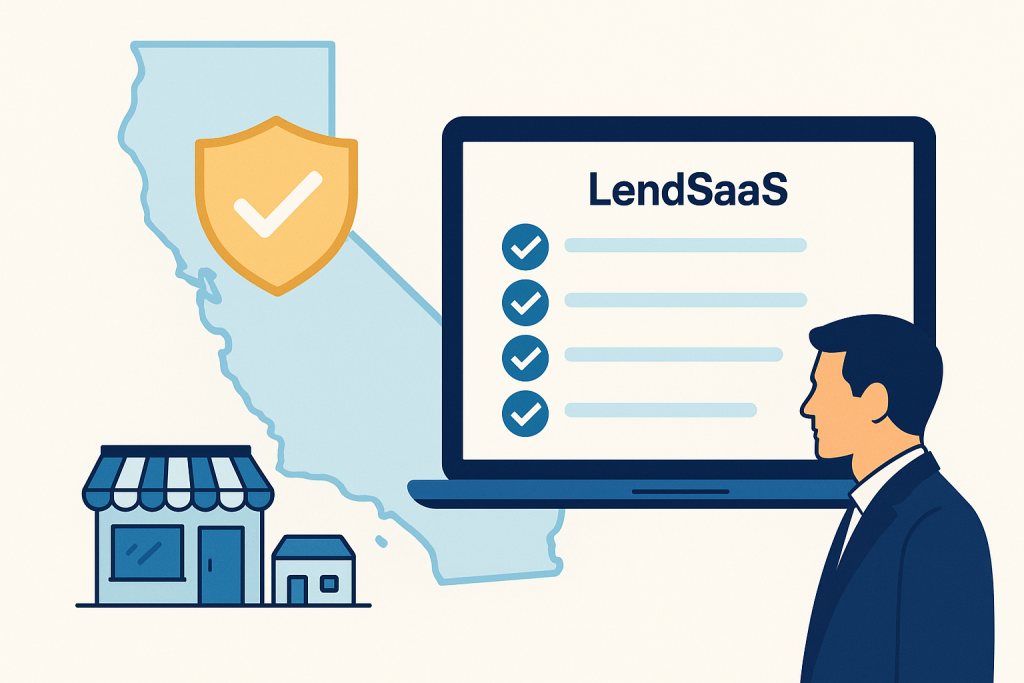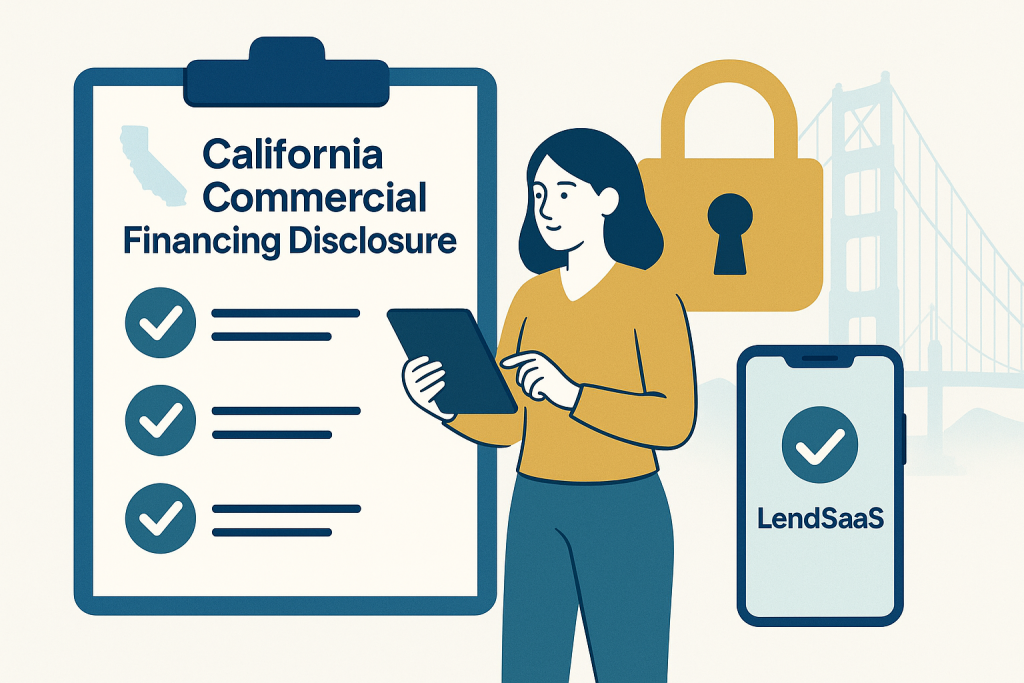Introduction
California has never been shy about regulating financial products that touch small businesses, and merchant cash advances (MCAs) have finally come fully under the spotlight. Specifically, California MCA Compliance. After years of hearings and comment periods, the state’s Commercial Financing Disclosure Law (CFDL) became fully enforceable for MCA providers on December 9 2022. The rule set, administered by the Department of Financial Protection and Innovation (DFPI), requires uniform, plain-language disclosures that mirror consumer lending forms yet respect the unique structure of revenue-based financing.
If you operate in or solicit California merchants, compliance is no longer optional. Violations can void contracts, trigger restitution, and expose officers to civil penalties. At the same time, California’s rules foreshadow what is coming in other large states—meaning that building strong workflows today is the fastest route to national readiness tomorrow.
This guide explains what “California MCA compliance” actually means, which transactions are covered, the documentation you must capture at each stage, and how LendSaaS automates the painful parts so your team can focus on funding deals, not formatting forms.
(Nothing here is legal advice; always consult counsel for your specific situation.)
1. MCA Basics—Why the Product Fell Under Regulatory Scrutiny
An MCA is not a loan; it is the purchase of a percentage of the merchant’s future receivables in exchange for upfront capital. Traditionally, brokers promoted MCAs as “fast and paperwork-light” alternatives to bank loans. Unfortunately, that speed sometimes came at the expense of clarity. California legislators heard stories of restaurants that thought they were paying a simple fee, only to discover the factor rate translated into eye-watering annualized costs once daily splits were considered.

Because California already requires consumer-credit disclosures, lawmakers decided small-business owners deserved a similar-level plain-English explanation—even though they are technically commercial borrowers. SB 1235 (2018) instructed the DFPI to build that framework, ultimately birthing the CFDL applicable to MCAs, factoring, revenue-based financing, and certain leasebacks.
2. California MCA Compliance Timeline at a Glance
| Date | Milestone |
|---|---|
| Sept 2018 | SB 1235 signed—DFPI tasked with drafting rules |
| Feb 2022 | Final CFDL regulations adopted |
| Dec 9 2022 | Enforcement begins for MCA and sales-based financing |
| 2024-25 | DFPI guidance letters and first formal audits |
3. Required Disclosures
California MCA compliance package is built around a Standard Disclosure Form (SDF) that must be presented before the merchant accepts a specific financing offer. The form must be stand-alone, 10-point font or larger, and delivered electronically or on paper.
Mandatory data points:
- Total Amount of Financing Provided
- Disbursement Amount (net funds)
- Total Repayment Amount
- Finance Charge
- Estimated Term
- Estimated APR (IRR method)
- Payment Frequency and Calculation Method
- Prepayment Policy
- Broker Compensation & Underlying Funder (if applicable)
On renewals you must regenerate the SDF using updated sales projections and label the disclosure “Renewal.”
4. Who Must Comply?
The CFDL applies when:
- The recipient is a business located in California or the offer is received in the state.
- The financing amount is $500,000 or less (indexed over time).
- The product is an MCA, factoring arrangement, revenue-based financing, or similar.
Out-of-state funders cannot avoid compliance merely by operating online; jurisdiction is triggered the moment the offer is directed to a California merchant.

5. Record-Keeping and Penalties
Funders must retain each signed SDF and supporting calculations for three years and produce them within 10 business days of a DFPI request. Non-compliance can lead to administrative fines up to $10,000 per violation, restitution of finance charges, contract voidance, and reputational damage that hampers future funding relationships.
Practical example: Assume you funded 200 California merchants last year and missed the APR box on half of the SDFs. At $10,000 per violation you face a theoretical exposure of $1 million—before counting potential restitution. Even if regulators settle for a lower figure, the legal fees and operational freeze that accompanies an enforcement action can cripple a midsize ISO. Investing a few dollars per deal in automated compliance is cheap insurance by comparison.
6. Best-Practice Compliance Workflow
- Deal Intake – Capture merchant location and flag California deals.
- Pricing Engine – Calculate factor rate and run DFPI APR algorithm.
- Auto-Generate SDF – Populate the latest template; lock editing.
- E-Delivery – Send for acknowledgement before the offer can be accepted.
- Audit Vault – Store the signed disclosure and calculation file in immutable storage.
- Renewal Watch – Auto-recalculate APR on any renewal or consolidation.
Building this pipeline internally is costly. LendSaaS offers a turnkey alternative.
7. How LendSaaS Transforms Compliance from Burden to Advantage
Real-Time Jurisdiction Detection
Applications are screened for California triggers; CFDL-mode activates automatically.
Certified Disclosure Generator
LendSaaS maintains the DFPI layout and updates it overnight whenever the state revises the form.
One-Click APR Calculator
Server-side calculations follow DFPI’s IRR spec, even for variable revenue splits.
Broker Oversight Dashboard
ISOs get a portal that forces SDF generation before they can download a term sheet.
Immutable Audit Vault
Completed SDFs and underlying spreadsheets flow into WORM storage ready for DFPI review.
Continuous Rule Monitoring
When other states adopt disclosure laws, LendSaaS adds new templates without code changes on your side.
API-First Architecture
Embed compliance in your own portal—send deal data, receive a PDF and APR value.
8. Case Study: Premier Funding LLC
A Los Angeles ISO migrated to LendSaaS in 2024. Within three months they:
- Cut quote-to-funding time by 28 percent.
- Passed a random DFPI audit with zero findings.
- Avoided an estimated $140,000 in penalties when LendSaaS flagged 17 renewal files missing updated APR tables.
9. What Happens Next? The Expanding Compliance Landscape
California’s rulebook rarely stays confined to California. New York, Utah, and Virginia already enforce their own commercial-financing disclosure statutes, each with small but important differences in APR methodology and formatting. Florida’s legislature introduced HB 1469 in early 2025, borrowing heavily from California while adding a merchant “cool-off” period. Federal agencies are also watching; the Consumer Financial Protection Bureau signaled in a March 2025 blog post that small-business financing transparency fits squarely within its mandate.
What that means for MCA providers is simple: the compliance target is moving, and the cost of lagging behind compounds every quarter. By investing in an adaptive technology layer now, funders can treat each new jurisdiction as a configuration update rather than a six-month engineering project.
10. Top Five Questions We Hear from MCA Operators
1. Do I need a California lending license to offer MCAs?
Generally no—MCAs are structured as receivables purchases, not loans. However, if you also offer term loans you may need a California Financing Law license.
2. What if the merchant’s revenues fluctuate?
The DFPI allows “reasonable projections” based on historical sales. LendSaaS stores the source data and the projection logic so an examiner can see exactly how you arrived at the estimate.
3. Can I include multiple offers on one disclosure?
No. Each specific offer—defined by amount, factor rate, and payment method—requires its own SDF. LendSaaS bulk-generates individual PDFs if you present tiered terms.
4. How are broker commissions displayed?
The SDF must show the dollar amount or a good-faith estimate of compensation the broker will receive. LendSaaS merges ISO fee data and flags zero entries so they can’t be overlooked.
5. Are electronic signatures acceptable?
Yes, provided they comply with ESIGN and UETA. LendSaaS integrates with DocuSign, Adobe Sign, and its own lightweight click-wrap module—all of which log IP address, timestamp, and hash of the document for evidentiary integrity.
11. The Bottom Line for Your Team
California MCA Compliance is sometimes portrayed as a cost center, but early adopters are proving it can be a growth lever: transparent pricing builds trust, streamlined workflows close deals faster, and robust audit trails attract institutional capital looking for clean portfolios. With regulations expanding, the choice is clear—spend valuable developer hours chasing templates, or let LendSaaS shoulder that burden while you focus on underwriting, marketing, and customer service.
Ready to see it for yourself? Book a demo and discover how simple compliance can be when it’s built into your tech stack.
California MCA Compliance rewrote the rulebook; the rest of the country is turning the page. Choose technology that turns compliance from an after-the-fact scramble into a built-in service promise—and watch how much easier it becomes to win repeat business, attract new ISO partners, and negotiate forward-flow arrangements with capital providers who prize operational discipline.


Leave a Reply